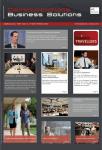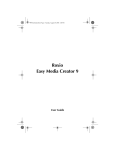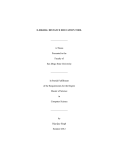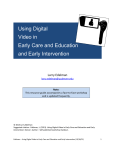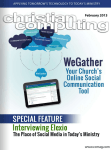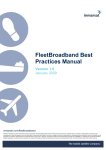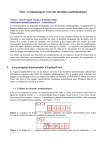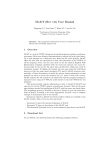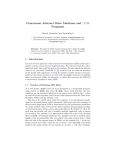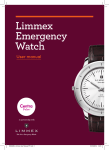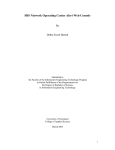Download Towards Good Web Conferencing System Design for Ubi
Transcript
Towards Good Web Conferencing System Design for Ubi-Media
Collaboration
Bin Yu1, Yong Rui
Microsoft Research
One Microsoft Way, Redmond, WA 98052, U.S.A.
{t-binyu, yongrui}@microsoft.com
ABSTRACT
Media, data and documents are becoming ubiquitous in the
past decade, across time zones and across organization
boundaries. Web conferencing systems emerged as
effective tools for people to communicate and collaborate.
These systems combine multiple distributed applications to
manipulate multimedia content within a conferencing
session, and achieved great results. However, despite great
development in such systems, current products on the
market are still far from perfect in many aspects. In this
paper, we first present an overview of existing systems, and
then identify good system design principles based on our
own experience with the existing systems. Finally, we
outline several interesting research directions that may
further enhance users’ collaboration experience.
1. Introduction
Web conferencing systems (WCSs) are the latest and one of
the most promising developments in the collaboration
world. Its primary applications include project/team
collaboration, training, marketing presentation, and
customer support services. We define a WCS as a
combination of hardware and software utilities that enable
information exchange between conferencing participants
via computer networks in real time. The hardware utilities
include computing devices, input/output peripherals and
communication networks. Example software utilities
include presentations, web co-browsing, whiteboard
sharing, application/desktop sharing, file transfer, text
chatting, instant messaging, audio/video communication,
polling, and session recording/playback. Figure 1 is a
screenshot of Centra [2], a WCS on the market, from its
user manual.
Various conferencing systems, e.g., [1][2][5][6][7][8][9]
[10][19], have been on the market for many years. But
their importance was not fully appreciated until the down
cycle of the U.S. economy in 2000 and the tragic event of
9-11. As more users had gone through the learning curve,
they started to realize the convenience and power of WCSs.
Specifically, WCSs are easier to set up and normally
cheaper than conventional video conferencing system [13].
1
In addition, WCSs do not require dedicated ISDN lines.
Compared with audio conferencing systems, WCSs allow
people to see each other, which is especially important
during the initial meetings. Furthermore, WCSs are better
than both video and audio conferencing in that they support
easy data collaboration, e.g., application sharing and
presentation viewing. According to Frost & Sullivan [7],
the worldwide WCS market stood at $472.1 million in
2003, and is expected to reach $3.02 billion by 2010.
Note that WCSs are different from conventional Instant
Messaging (IM) systems, such as Yahoo Messenger [20], in
that IM systems primarily facilitate people to exchange
quick textual messages, while WCSs provide much more
powerful visual/audio channels for collaborative discussion
on more complicated problems. However, one interesting
trend in the WCSs development is to invoke collaboration
tools (such as PowerPoint presentation, audio/video
conferencing and whiteboard) from within the IM interface.
There exist several comprehensive surveys and guides on
web conferencing products and services from end users’
perspective, e.g. [3][14][15]. There is, however, little
research on WCS design issues. This paper tries to fill that
gap. Specifically, we want to
1.
identify WCS design principles that should be
encouraged or avoided, based on the authors’ first-hand
experiences; and
2.
suggest future research directions that may lead to
significant improvement in user experience with WCSs.
The rest of this paper is organized as follows. We will first
give an overview of existing WCSs in Section 2, and then
present system design principles in Section 3. We promote
several future research directions in Section 4, and conclude
the paper in Section 5.
2. Overview of Existing WCSs
There are many WCSs on the market today. In general,
there are two major competing trends in the WCS industry.
On one hand, some systems target at large organizations to
reduce their huge travel costs by providing comprehensive
solutions. Example systems include WebEx [19] and Centra
[2]. Such systems generally provide more sophisticated
This project was done during the first author’s internship at Microsoft Research. His current email is [email protected]. To provide an
unbiased view of existing WCSs, because of authors’ affiliation, we deliberately do not discuss Microsoft Live Meeting in this paper.
almost all conferencing tasks into one facility – desktop
sharing. For example, distant PowerPoint presentation is
extremely easy because the presenter does nothing more
than running a local PowerPoint presentation. Similarly,
Convoq ASAP [5] is very easy to use for all users who are
already familiar with IM tools such as Yahoo Messenger
[20], because all conferencing facilities are naturally built
on top of existing IM interface.
Figure 1. An example WCS web interface from Centra [2].
facilities, e.g., better audio-visual quality, and more
software utilities. This is at the expense of higher price and
higher resource requirement in terms of network bandwidth,
computation power and capturing devices.
On the other hand, some WCSs weight simplicity with more
importance, and they focus on a few key features that work
well enough for most daily activities. Representative simple
WCSs include Glance [8], Convoq ASAP [5], Sightspeed
[17] and Linktivity Webdemo[10]. They focus on smaller
scale conferencing scenarios for individual users and small
companies and often ask for much lower prices. For
example, Glance [8] simplifies several collaboration
features into the application sharing facility, which may not
be best for large group of participants, but fits well to the
needs of smaller group of users.
Despite the differences in comprehensive and simple
systems, there are many common issues that both camps
need to properly address. In the rest of the paper, we want
to identify such design principles that are worth to follow
for all WCSs, and promising future directions that may
eventually lead to a solution that best serves the customers.
3. Detailed System Design Principles
3.1 Ease of Use:
Ease of use has always been the top design principle for all
computer systems, and web conferencing is no different.
After using and studying many existing systems, we
summarize the following key principles that can lead to
ease of use.
3.1.1 Following Users’ Previous Experience
The easiest way to teach a user how to use a new tool is to
make it work like an old tool that the user is already
familiar with. By previous experience, we mean both the
experience in using other computer tools and the experience
that are not related to computers at all. For example, the
Glance [8] system achieves great simplicity by unifying
This principle of “experience-driven design” can be used to
simplify many tasks. For example, the “file sharing” feature
is not straightforward in most WCSs because a user often
has to explicitly “send”, “receive”, “upload” or “download”
the files. However, considering that users are familiar with
simple “copy” and “paste” or “drag and drop” operations,
we can create a pseudo drive/directory on the local PC’s
file system that represents remote peers so that users can
resort to what they already know.
3.1.2 Hide What Is Not Being Used
Many a time the complexity of using a WCS comes when a
user cannot easily find the controls that s/he needs, because
there are too many menus and buttons. For example, as the
authors tried out some WCSs that provide rich
functionalities, we found it’s not easy to find the menu item
or button on the toolbar when we wanted to quickly change
or check some settings or repeat the same action. To solve
this issue, it is better to define several working “modes”,
e.g., “application sharing mode”, “Internet co-browsing
mode”, “presentation mode”, so that in each mode the
toolbar and menu items are adapted to the hot tasks for that
mode.
3.2 Customization
Customization gives a user the control over what kind of
service he/she enjoys, and we believe a good WCS should
provide customizability in the following aspects:
3.2.1 Resource Consumption Level
Different users have different resource availabilities in
terms of hardware capacity (CPU, memory, disk, screen
space, etc.), and network connection bandwidth. Even if
two users have similar availabilities of resources, they may
still want to allocate different amount of resource to a
particular conferencing session. Therefore, it is desirable
that a WCS gives advanced users the choice of specifying
how much resource the system can consume. For example,
in terms of screen space for the user interface, it may not be
a good idea to include all the functions into one large
window that takes the entire desktop, not to mention in an
input-blocking mode, because the user may well want to
take care of other applications at the same time. NetMeeting
[11] has done a good job in this aspect by using a small
window for each task, and left users the control of
allocating the screen space.
Along this line of reasoning, all types of Quality of Service
(QoS) should be customizable based on resource
availability and user requirements, such as video quality,
audio quality, PowerPoint presentation quality and session
recording quality. From our observation, very few WCSs
provide option for users to specify what the resource budget
is and what level of quality is desired. With the dynamic
transcoding/transformation techniques, such adaptations are
realistic to implement.
3.2.2 Implementation Polymorphism
Polymorphism refers to function overloading in object
oriented programming languages, i.e., for the same method
call, different objects act differently based on their own
purpose of existence. We can borrow this idea into the
design of WCSs because different users may have different
computing devices or resource availabilities, and we want
the same function to be carried out in different ways based
on each individual situation.
For example, for the PowerPoint presentation facility,
currently almost all existing WCSs convert the PowerPoint
file into an image format, e.g., PNG or JPEG, and then
present the same presentation to all viewers. This “one size
fits all” approach may not be adequate: some users may
have high bandwidth connection and PowerPoint installed
on their machine, so that they can watch a PowerPoint
presentation that runs on their own local machines and is
controlled by the remote presenter; on the other hand, some
users may only have a small iPAQ with limited wireless
connection, and the JPEG images would not fit into the
screen. Here, if we apply the idea of polymorphism, we can
allow the same PowerPoint presentation function to be
realized in a customized way for each participant:
For those clients with PowerPoint application
installed, whether it is on Windows, Linux or
Macintosh platform, download the PowerPoint file
and then run PowerPoint locally. The presenter’s
interactions (mouse movement or keyboard events)
can be sent to the participant’s local PC to follow what
would happen at the presenter’s PC.
For those users without PowerPoint application
installed, they are sent differently sized JPEG images
based on how much bandwidth they have and how
large their screen sizes are.
Note that this customizability may seem contradictory to the
principle of “ease of use”. But in fact they are talking about
two different dimensions. Customizability refers to the
process of setting up the WCS, while ease of use refers to
the process of using the WCS. Of course, the customization
step itself can be made easy to use, too. In addition, ease of
use is more desired for novice users, and as they become
more familiar and experienced with the system,
customization will become important for them. Based on
our observation, it also a good idea to for WCSs to provide
several sets of predefined composition of the functionalities
and parameter settings based on the typical user scenarios.
3.3 Reliability
No one wants to use a system that may crash during an
important meeting. Because a WCS is in fact a composite
session of several distributed applications, they are more
vulnerable than ordinary systems. In such a situation,
system designers need to take the following two principles
into consideration:
3.3.1 Independent Service Component
When a fault occurs, it normally comes from one particular
function. Therefore, if different facilities are as loosely
coupled as possible, they may still work well when one or
more facilities fail. For example, in many existing systems,
one task often freezes the whole interface until it is done,
such as PowerPoint file uploading or application sharing.
That is, when a user is using these features, he cannot
access any other features from the interface. This is very
likely to cause the whole interface to crash if an error
occurs during the file uploading. We believe that a more
robust design is to model all the facilities as independent
applications sharing a minimal set of session information.
3.3.2 Distributed Architecture
A centralized server is usually the source of problem
because it has high traffic/computation pressure and it is
often the target of attack. To increase scalability and
robustness, a good WCS should be designed with
distribution of functionality in mind. As personal computers
become more and more powerful, more tasks could be offloaded to the client end from the shared server. For
example, currently most systems store the meeting content
in a centralized server and then distribute to all participants
on request. This is not reliable because if the content server
is down, the meeting can not continue. Instead, considering
the low price of hard disks, it is better to replicate the
content to a selected set of powerful participant PCs before
hand. In fact, some systems, e.g.,Groove [9] and Cybernar
[6], are completely server-less and they adopt the Peer-toPeer architecture to remove the single-point failure and
utilize the computing power residing on each participating
PCs. This is a very promising direction to go that reduces
overall cost and increases reliability.
3.4 Security
Needless to say, security is very important for WCSs, and
almost all the existing systems have made great efforts in
securing the integrity and confidentiality of conferencing
content. Two most commonly used protections are
password authentication and 128-bit Secure Socket Layer
(SSL) encryption. Because of page limitation, for a detailed
discussion, readers are referred to [3].
4. Future Directions
Although quite many WCSs are on the market today, users’
experience with them is still far from ideal. In this section,
we propose a few interesting directions that may bring user
experience to a higher level.
4.1 Asynchronous Ad-hoc Collaboration
Existing WCSs all focus on real-time collaboration.
However, considering the popularity of the two widely used
applications of the Internet, www browsing and email,
asynchronous collaboration is a very important part of the
collaboration experience. For example, sometimes it may
be very hard to find a common time slot for a group of
people to have a meeting together, and in many occasions
people need to meditate and search for related materials
before they raise their opinions in a group discussion.
Consider a web forum way of asynchronous collaboration:
one participant may start a discussion thread by sharing a
piece of video and PowerPoint slides on the conferencing
catalog, and then he gets offline. Later, when any other
participant becomes online, he can review the existing
posts, and take his time to check related information and
organize his thoughts. Then he may add his comments into
the discussion thread by adding new slides, notes,
whiteboard drawings, a few web links, or even a piece of
audio/video recordings. The updates to the thread will
trigger alert notification to all interested parties who may be
offline temporarily. When a brilliant idea suddenly strikes
someone, he does not have to call for an emergency
meeting, but only needs to “join” the asynchronous meeting
and presents his thoughts right away.
4.2 Smart Recording and Playback
Recording and playback of web conferences is still an
under-studied field. We propose four directions where
improved user experience may be achieved.
Event-based Recording/Playback
Almost all existing systems use video-based recording of
what the on-site participants have seen and heard. The file
size is normally very large, yet the video/audio quality is
generally not satisfactory. Considering the fact that the state
of the recording session evolves at each user interaction
event, a past conference session can be completely
reconstructed by simulating the original participants’
interactions (events). Specifically, all the data files (e.g.,
PowerPoint slides, word documents, etc.) and all the user
interactions that change the state of the conference session
(e.g., document navigation, annotation, whiteboard strokes,
session join/leave activities, etc.) are stored separately.
Later on, when a user wants to playback the session, he can
use the recorded events as natural indexes into the session,
and jump to any event to start the playback. The system can
quickly reconstruct the session state at the starting point as
what it was during the original session, then all the
following interactions are replayed to simulate what
happened in the original session. There are several benefits
of event-based recording/playback: 1) a natural timeline
with event-based indexes is created as the conference
session evolves; 2). Playback quality is higher because the
users see exactly what the original session would be, while
for video-based recording there are normally quality loss
due to down-sampling and compression. 3). If the user
wants to download the recording for playback, he will only
download the documents and interactions, so the file size
can be greatly reduced compared to downloading a videobased recording. 4). For on-demand browsing of meetings,
it requires much less bandwidth than streaming the actual
video.
With the event-based recording/playback, several other
improvements can be achieved
Conference Session Retrieval
When the amount of recordings becomes large, users may
desire to search through recordings of conferences for
specific information. With traditional video/audio
recording, because the video/audio content is not easily
understood by computers, retrieval results are often
dissatisfactory. However, with the event-based recording,
two advantages exist: 1). It preserves the related documents
in their original formats, which are normally textual, so we
can leverage the more mature techniques in text-based
retrieval. 2) Metadata, e.g., events, is logged, which can be
used for retrieval.
Conference Session Summarization
Summarization of a long conference session into a short
highlight segment is often desirable for faster browsing and
searching for specific information. With traditional
video/audio recording, summarization is not easy because
of the limitation in video/audio content understanding
technologies. However, with event-based recording, we
have the natural indexes that segment the session into small
“shots”, so summarization can be done by prioritizing these
shots so that more interesting and important shots are
presented to users who want a quick review of the session.
Specifically, the priorities can come from two sources:
content analysis and user interaction analysis.
For content analysis approach, the shots in a session can be
weighted differently based on whether important events
happened during that shot and whether the related
document
segments
contain
important/interesting
information. Note that heuristics may be needed to
determine the importance of events and what information is
more important or interesting, and this knowledge may
come from the particular conference topic or be manually
specified by users.
For user interaction analysis approach, the log analysis
approach [21] can be applied to utilize users’ engagement
and interactions to gain understanding of the session
semantics. Specifically, there are natural inherent “links”
between media content such as PowerPoint slides, web
slides, whiteboards and shared applications, and
“interesting” pieces of content will tend to be strongly
correlated to each other. On the other hand, playback users
differ in their interests in the materials and engagement in
the browsing process, so their interaction will have different
weights in determining the value of the content segments
they visit. Therefore, by utilizing the reinforcement between
engaged users and interesting content pieces, we can rank
the recorded content pieces in their interestingness to users
and assist future users in their browsing.
Adaptable Recording
Currently almost all WCSs “publish” final recording files
that can not be updated later. With event-based recording,
the whole session is segmented into small shots based on
different events, which provides the opportunity for later
users to “re-join” a past conference session by inserting his
own interactions. For example, for a distant learning class,
the teacher may ask each student to present his/her ideas on
a topic. Imagine that one student is absent from that class,
he can make up the class by browsing through the
recording, and insert at the middle of the conference session
his own responses. And for later reviewers, the last
student’s interactions are presented just like other students,
though some notation may be added to indicate this is a
make-up recording segment.
4.3 Anonymity
In many scenarios, e.g., sales presentation, participants of a
conference are strangers to each other. Though they will
authenticate themselves, they may not want others
(sometimes even the presenter) to know that they are in the
session. Some users may want to hide themselves initially,
and then “show up” when they have some questions. As far
as we observe, no existing system deals with this
requirement.
4.4 Improved Video Conferencing Capability
Because of the high bandwidth requirement for the video
channel, most existing WCSs take video as an add-on
component that is normally not activated. However, face-toface contact has always been a very important factor in
human communication, as facial expressions and body
languages often tell more than words. In addition, as
pointed out in a recent survey conducted by RoperRAW
[18], people tend to be more focused in a face-to-face
meeting, while they may do other work such as checking
emails or surfing the Internet if no video image is being
captured. To increase meeting/marketing effectiveness,
providing better video quality is important for next
generation WCSs. As the last mile bandwidth grows higher
and as new video coding standards such as H.264 and
MPEG4 become widely used, video will become more
accessible in the future.
4.5 Beyond What We Have Today
A web conferencing session is more than a composite of
several distributed applications for the following two
reasons: (a) there can be multiple users giving inputs to the
same application, and (b) these applications run at the same
time and share common session metadata and critical
resources, such as CPU power and screen space.
There could be many new application scenarios that were
not thought about before because of (a). For example,
before the wide use of WCSs, it is rare that multiple users
will work on the same document at the same time.
However, now that every session participant has a set of
mouse and keyboard, they can work on the same
whiteboard, PowerPoint slide, word document or
spreadsheet at the same time. Imagine that if a chip design
company has an urgent project that normally takes each
designer three days to finish, now they can have these three
designers work together on the same blueprint at the same
time in parallel and finish the work in one day.
On the other hand, because of (b), applications that work
perfectly alone may need additional functions when used
closely with other applications. For example, currently
PowerPoint presentations take full screen mode only, but
when used in a web conferencing session, it may be desired
that it can run in a particular window, such that it allows
overlay of a small Picture-in-Picture window that shows a
video window or another PowerPoint slide or even a web
page.
5. Conclusion
WCS is a key solution to improving people’s ubiquitous
access to media, data and information. As a result, it can
significantly improve people’s efficiency and productivity
in their daily business, especially when they are distributed.
Based on our own research experience as well as the
observations on commercially available WCSs, we
reviewed the strength and weakness of existing WCSs,
proposed a set of design guidelines, and discussed
interesting future research directions. As the world is
becoming more flat, we envision that future WCSs will play
more and more important roles in helping people access,
manage and collaborate on their data.
6. Reference
[1] Best Web And Videoconferencing Alternatives To
WebEx, Live Meeting, Centra For The Small, NonProfit
And
Home-Based
Company,
http://www.masternewmedia.org/2003/11/13/best_web
_and_videoconferencing_alternatives.htm
[2] Centra, http://www.centra.com/
[3] Cisco, Best practices in web conferencing security,
http://itpapers.techrepublic.com/abstract.aspx?docid=8
3438&promo=400111&lop=wpr.20,1011, white paper
[4] Conferguide 2004, web conferencing guide,
http://www.conferzone.com/services/conferguide_thoit.
html
[5] Convoq ASAP, http://www.convoq.com/
[6] Cybernar from Terra Firma,
http://www.terrafirmacomm.com/products/cybernar.ph
[7] Frost and Sullivan, http://www.frost.com/
[8] Glance, http://www.glance.net/
[9] Groove, http://www.groove.net/
[10] Linktivity webdemo, http://www.linktivity.com/
[11] NetMeeting,
http://www.microsoft.com/windows/netmeeting/
[12] Orbitalk, http://www.orbitalk.com
[13] PolyCom, http://www.polycom.com
[14] Rich Media Conferencing 2004,
http://www.wainhouse.com/reports/rmc2004.html
[15] Robin Good's official guide to web conferencing and
live
presentation
tools,
http://www.masternewmedia.org/reports/webconferenci
ng/guide/
[16] Rui, Y., Huang, T. S., and Mehrotra, S. , “Constructing
table-of-content for videos”, Multimedia Systems, V 7,
Issue 5, September 1999
[17] Sightspeed, http://www.sightspeed.com
[18] Wainhouse Research Bulletin Archives, Vol. 4, Issue
#44,
http://www.wainhouse.com/files/wrb-04/WRB0444.pdf, Dec 8, 2003
[19] WebEx, http://www.webex.com
[20] Yahoo Messenger, http://messenger.yahoo.com/
[21] Yu, B., Nahrstedt, K., Video Summarization based on
User Log Enhanced Link Analysis, ACM Multimedia
2003







